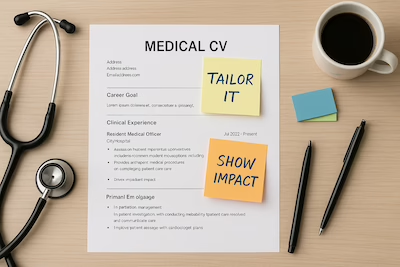For International Medical Graduates (IMGs) who have made it into the Australian healthcare system—either through the Competent Authority Pathway or Standard Pathway—transitioning from non-training to accredited training roles can be one of the most significant (and competitive) career steps.
As someone who’s helped guide dozens of IMGs into their first training positions across specialties like General Practice, Internal Medicine, Emergency, and Psychiatry, I’ve noticed that the CV is often the first thing holding candidates back. Not because they lack the skills—but because their CV doesn’t clearly demonstrate their readiness for training in the Australian context.
Let’s break down the top 5 CV mistakes IMG doctors make when applying for training posts, and how to avoid them.
Summary: CV Mistakes IMGs Make When Applying for Training
The most common CV mistakes IMG doctors make when applying for training posts in Australia include: failing to highlight relevant clinical experience that shows readiness, using terminology unfamiliar to local panels, listing tasks instead of impact, writing without tailoring, and underemphasising non-clinical contributions like teaching and quality improvement. A strong CV shows more than competency—it demonstrates growth, reflection, and readiness to thrive in a training environment.
Top 5 CV Mistakes IMGs Should Avoid
1. Failing to Demonstrate High-Level English Communication Skills
Meeting the Medical Board of Australia’s English language requirement (via IELTS or OET) is a baseline for registration—but training programs expect far more. Strong communication is central to safe, effective care, and your CV is often the first test of how well you write, explain, and present yourself professionally.
🔎 Why This Hurts Your CV:
- Even competent doctors can be overlooked if their CV reads awkwardly, lacks clarity, or contains grammatical issues.
- Panels assess your written communication based on your CV itself, not just test scores.
✅ How to Fix It:
- Clearly state your English test results at the top of your CV, especially if they are well above the minimum requirement (e.g. IELTS 8+ or OET A grades). This subtly reassures panels of your communication standard. Example (CV Header): IELTS Academic: Overall 8.5 (Listening 9.0, Reading 8.5, Writing 8.0, Speaking 8.5)
- Use your CV to show your communication skills:
- Write in clear, confident, and fluent English.
- Avoid long or overly technical sentences.
- Ask a local colleague to proofread—or consider professional editing.
- Highlight communication-heavy experiences:
- Patient and family education
- Clinical handovers
- Discharge planning and referrals
- Teaching or presenting in English-speaking settings
✏️ Strong Example:
“Communicated directly with patients and families from diverse backgrounds in English, explained treatment plans, and managed discharge instructions in collaboration with allied health staff.”
2. Not Demonstrating Readiness for the Australian Training Environment
Many IMGs applying for training posts haven’t yet had formal clinical experience in Australia—or only limited exposure through observerships or bridging programs. That’s not a deal-breaker, but failing to show readiness for the Australian system is.
🔎 Why This Hurts Your CV:
- Selection panels want to see that you understand how medicine is practised in Australia—even if your clinical experience is overseas.
- If your CV doesn’t bridge that gap clearly, you may be overlooked for someone with a more “local” feel, even if they’re less capable.
✅ How to Fix It:
- Use your overseas clinical experience to highlight transferable skills—such as managing acute presentations, leading ward rounds, or working in resource-limited settings.
- Show familiarity with Australian healthcare values:
- Multidisciplinary teamwork
- Escalation and handover
- Patient-centred care
- Safety and systems thinking
- If you’ve worked in non-clinical jobs in Australia (e.g. admin, aged care, support roles), include them briefly to show your adaptability, communication, and system exposure.
- Mention any involvement with bridging courses, cultural safety training, or professional development in Australia—these demonstrate commitment to integration.
✏️ Example:
Medical Officer – Emergency Department
Tertiary Hospital, India | Jan 2021 – Dec 2022
- Managed high-volume acute presentations independently, including trauma and sepsis
- Led triage and handover between departments; coordinated with nursing and allied health teams
- Regularly taught junior doctors and medical students in bedside teaching sessions
- Currently completing ALS and cultural competency training in Australia to support transition to local clinical practice
3. Using Non-Standard or Overseas Terminology
While you may have trained in the UK, India, Sri Lanka, or the Philippines, your CV needs to read like it was written for Australian selection panels.
🔎 Why This Hurts Your CV:
- Panels may not understand titles like “SHO” or “House Officer.”
- It can create ambiguity about your seniority, scope of practice, or system familiarity.
✅ How to Fix It:
- Use equivalent Australian job titles: Intern, RMO, Registrar, etc.
- Where necessary, explain the overseas title briefly in parentheses: e.g. “Senior House Officer (equivalent to PGY2)”
- Avoid overly academic or administrative terms unless required (e.g. “clinical attachments,” “electives”)—instead, focus on clinical experience and patient care.
4. Listing Duties Instead of Demonstrating Clinical Impact
A common mistake is simply copying job descriptions into the CV—“managed patients,” “attended ward rounds,” “performed procedures”—with no reflection on outcomes or achievements.
🔎 Why This Hurts Your CV:
- Training programs look for candidates who learn, lead, reflect, and contribute to improvement—not just follow instructions.
- If everyone’s CV lists the same tasks, yours needs to stand out by showing how well you did them.
✅ How to Fix It:
Use action statements and outcomes to describe your work:
- “Independently managed 6–8 inpatients during after-hours shifts with timely escalation of care”
- “Led intern orientation session and developed a digital resource to support onboarding”
- “Initiated weekend discharge planning huddles, improving Monday bed availability”
Remember: your CV should tell the story of a doctor who is ready for training, not just employed.
5. Not Tailoring the CV to the Training Program or Employer
One of the most overlooked strategies is tailoring your CV to the specific training program or hospital. Many IMGs submit a single CV to every training post they apply for.
🔎 Why This Hurts Your CV:
- A generic CV shows a lack of insight into what each program values.
- You miss the chance to showcase your fit for their training environment—rural vs metro, procedural vs generalist, high acuity vs continuity care.
✅ How to Fix It:
- Update your Career Goal at the top of the CV to reflect the position and your pathway to registration: “Aspiring trainee with strong interest in general medicine and evidence-based care, pursuing the standard pathway to practice in Australia and seeking to contribute to the RMO program at [Hospital Name] with a view to long-term advancement in internal medicine.”
- Organise your experience to highlight the most relevant roles first (e.g. ED rotations for Emergency training).
- Reflect hospital-specific values—such as rural commitment, teaching, and quality improvement—through your achievements.
6. Underrepresenting Teaching, QI, and Professional Development
Many IMG doctors focus their CVs entirely on clinical roles and forget that training selection panels value a well-rounded doctor.
🔎 Why This Hurts Your CV:
- Programs want evidence that you’re involved beyond the bedside.
- Teaching, audits, quality improvement, and professional development show you’re committed to growth and capable of contributing to the culture of the training program.
✅ How to Fix It:
Create clear, separate sections for:
- Teaching Experience: medical student tutorials, intern mentoring, and hospital education sessions.
- Quality Improvement / Audits: even informal audits count—describe aim, process, and outcome.
- Professional Development: ALS, EMST, RMO prep courses, cultural safety training.
If you’ve presented at a hospital meeting or participated in morbidity & mortality reviews, include it—these are all valued in the training context.
💡 Bonus: Key Principles of a Strong IMG CV
- Structure matters – Use clear headings, consistent formatting, and bullet points.
- 2–4 pages is ideal, but go longer if the content is relevant and adds value.
- Tailoring is critical – don’t recycle a CV without adjusting for the employer.
- Impact over activity – show what you’ve contributed or improved, not just what you were assigned.
✅ Suggested CV Structure for IMGs Applying for Training
- Contact Details Name, email, phone, AHPRA registration status, location (optional)
- Career Goal (2–3 lines) Role-specific and reflective of your interest in the specialty/training program
- Clinical Experience Reverse chronological. Emphasise Australian experience with clear role descriptions.
- Education & Qualifications Medical degree, graduation year, AMC status, bridging programs
- Professional Development ALS, workshops, conferences, bridging courses
- Teaching Peer teaching, tutorials, intern support, presentations
- Quality Improvement / Audit Aim, methods, your contribution, outcomes (if known)
- Referees At least two—ideally Australian-based supervisors or consultants
Related Questions
1. Should I include overseas clinical experience on my CV?
Yes—but keep it brief unless it’s highly relevant. Prioritise your Australian clinical roles, especially those within the last 2–3 years.
2. How long should my CV be?
Aim for 2–4 pages. If your CV goes over slightly but remains well-organised and relevant, that’s acceptable.
3. Do I need different CVs for different hospitals?
Yes. You don’t need to rewrite everything, but your Career Goal and the way you highlight your experience should be customised for each application.
Meta SEO Elements
- Meta Title:
- Meta Description: Are you an IMG applying for training in Australia? Avoid these 5 common CV mistakes that could cost you an interview. Learn what selection panels are looking for.
- Meta Keywords: IMG CV mistakes, CV tips for training, Competent Authority Pathway, Standard Pathway, medical CV Australia
- Suggested URL: /cv-mistakes-img-training-australia
- Featured Image Prompt: A professional, neat medical CV on a desk with a stethoscope, pen, and sticky notes that say “tailor it” and “show impact,” symbolising IMG-focused CV preparation.
Related Posts
-
Coaching for Doctors. What Are the Key Benefits?
There are many key benefits or advantages to coaching for doctors, including better communication, time management, self-awareness, and problem-solving skills.
-
How To Write A Medical CV. The Ultimate Guide.
Updated for 2025. Tips From a Medical HR Expert On How to Write a Medical CV or Resume. Includes What To Put On the All-important 1st Page. Examples & Illustrations.
-
Medical Recruitment Agencies: Should You Use One? Independent Review
A question I am often asked by other doctors is when is a medical recruitment agency a good idea. Not surprisingly when you google this topic you get a list of articles written by medical recruitment agencies so I felt it would be useful to add an independent perspective. Some of the key reasons you…



